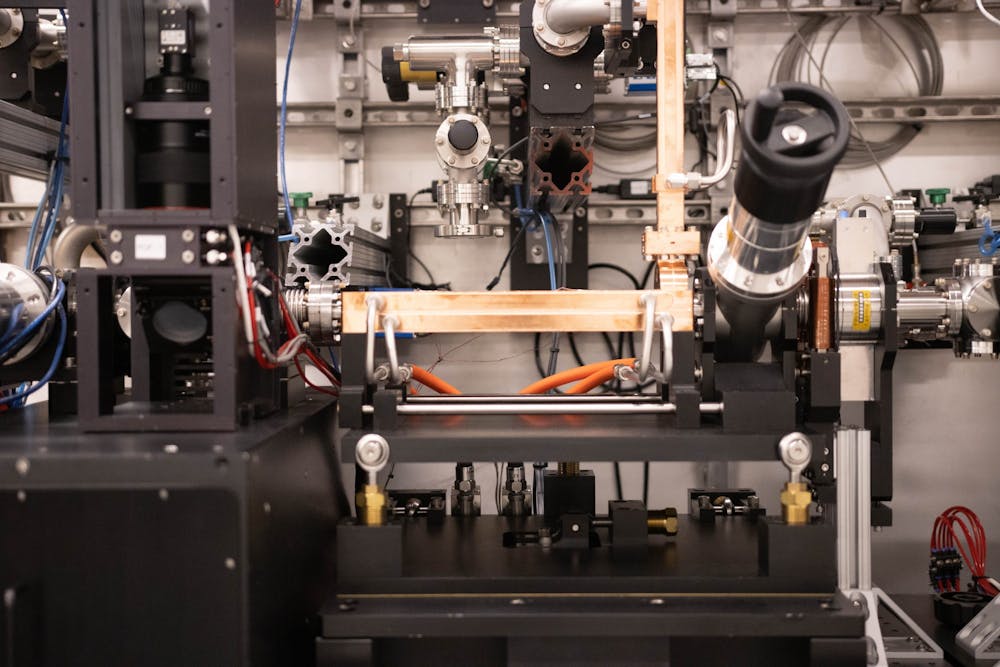ASU's compact X-ray free electron laser will be the first of its kind, allowing for experiments that typically require miles of machinery to be done in one basement.
However, given the project will take about five years to be completed, the focus is currently on its first phase: the compact X-ray light source (CXLS). The overarching CXFEL project is to hit a sample with a series of X-ray pulses to create a series of images.
"The overall research effort is the CXFEL project," William Graves, chief scientist of the CXFEL Lab, said. "It has two major phases and lots of phases within it."
The strides taken with the CXLS facility in recent weeks are significant.
"We've produced X-rays," Graves said. "We're just doing the final connections ... and we think that by spring, we'll be doing our first X-ray science experiments in the hutch (the experimental room)."
READ MORE: Touring ASU's CXFEL facility: X-ray science, lasers up close and still in progress
This transition from a dormant stage to active experimentation marks a significant milestone in the CXLS, pointing towards a collective ambition for advancements in X-ray diffraction.
Moving ahead, the subsequent step involves careful calibration and optimization of the CXLS, which has recently been completed.
Following this, the ambition escalates towards the construction of the CXFEL itself, a phase that promises to catalyze a new era of scientific discovery through the generation of ultrafast X-ray pulses.
Given the accuracy needed, the pursuit of femtosecond pulse precision within the CXFEL and CXLS projects necessitates an unwavering commitment to stability in every aspect of the facility's infrastructure.
"Now what we're going to do is we're going to start renovating the entire basement. And every step of that renovation involves asking questions related to things like, how do we keep everything as stable as possible?" said Samuel Teitelbaum, assistant professor at the CXFEL Lab.
Leveraging their robust experience from large-scale XFELs, the CXFEL team imbues their project with the precision required for femtosecond-level performance. This knowledge enables them to circumvent common developmental challenges and hone in on optimizing established techniques.
The CXLS is on the verge of transitioning from construction to action, heralding an impending surge in scientific research and experimentation.
Simultaneously, the technological systems that deliver the sample are being incorporated by others on the team.
"The focus right now is to implement the microfluidic systems that we need to bring protein samples into the X-ray beam," said Richard Kirian, associate professor at the CXFEL Lab.
The success of this operation is paramount, as the accuracy of sample delivery directly impacts the quality of data obtained, setting the stage for substantial progress in structural biology.
Finally, in order to start experiments, the light source must be directed to the right place.
"I hope that in a few weeks, I will be able to tell you that we have X-rays in the hutch (experimental room)," said Teitelbaum. "That means that the next step is to take those X-rays, put another optic in the beam, focus them onto a target and see a diffraction pattern from the sample."
Diffraction patterns, such as those through proteins, can be used to observe interactions that could never be seen before with any known technology. Biological processes, such as the metabolism of medicine or photosynthesis, can be viewed dynamically.
ASU continues to reinforce its position at the forefront of innovation with the CXFEL, nearing a significant breakthrough. After numerous enhancements and meticulous tuning, the scientific community is poised to witness the first diffraction patterns from the CXLS in the spring, heralding a new chapter in structural biology.
Edited by River Graziano, Jasmine Kabiri and Caera Learmonth.
Correction: The original story included the wrong title for Dr. Graves. The story was updated with the correct position on November 10, 2023 at 9:14 p.m.
Reach the reporter at dmanatou@asu.edu.
Like The State Press on Facebook and follow @statepress on X.
Dimitra is a junior studying biomedical engineering and physics. This is her second semester with The State Press. She has also worked as a research assistant in Kirian Lab.




